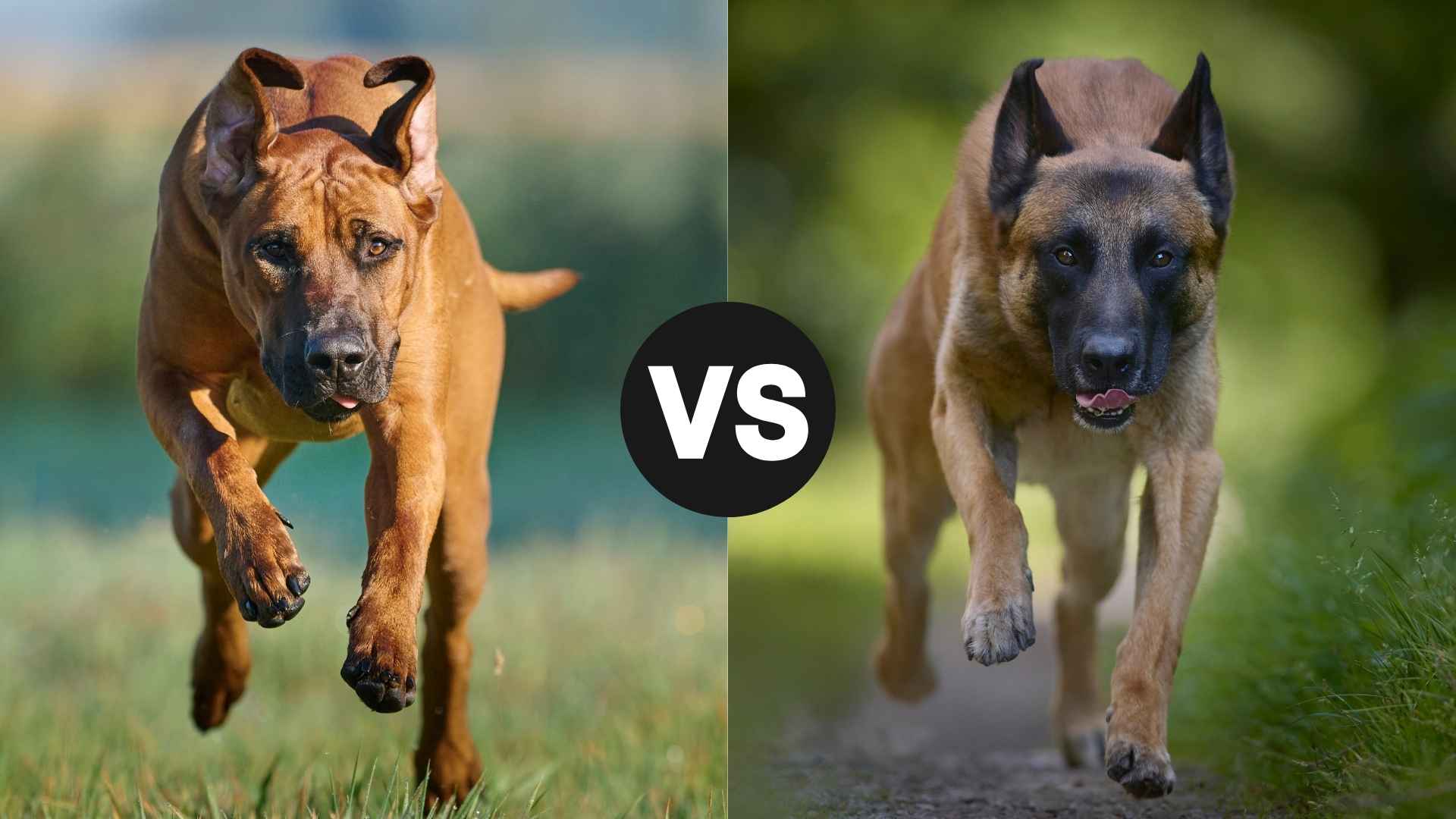You want a dog that loves your family, but won’t let a stranger get too close.
You’ve probably come across two names: Rhodesian Ridgeback and Belgian Malinois. Both are strong, loyal, and fearless, but they bring protection in different ways.
The Ridgeback is a silent watcher—calm, confident, and brave without showing off. The Malinois, on the other hand, reacts fast and works hard, trusted by police and military teams for a reason.
So, which protector is right for your home? This guide will walk you through how each breed behaves, what they need, and why their instincts matter. You’ll learn about their upbringing, their bond with families, and what makes them tick.
Rhodesian Ridgeback vs. Belgian Malinois
Belgian Malinois vs. Rhodesian Ridgeback: Size and Weight Comparison
Compact Power vs. Muscular Bulk
At first glance, both breeds look built for action, but their size tells different stories. The Belgian Malinois is leaner and more compact, standing about 22 to 26 inches tall and weighing between 40 to 80 pounds, depending on gender and build. Despite their lighter frame, they’re pure muscle and energy — an ideal choice if you’re looking for an athletic dog that can keep up with serious physical activity.
In contrast, the Rhodesian Ridgeback brings a heavier, more robust presence. They typically stand 24 to 27 inches tall and can weigh anywhere from 70 to 90 pounds. Ridgebacks are strong, with deep chests and dense bone structure — originally bred to track lions, so the added mass serves a purpose.
Frame and Proportions Matter
The Malinois has a more angular, streamlined silhouette, which gives it agility and speed. Their lighter frame makes them suitable for roles requiring sharp reflexes and quick pivots, like police and military work.
Meanwhile, Rhodesian Ridgeback dogs are broader across the chest and more grounded, built for endurance rather than explosive bursts of movement.
Trainability and Intelligence: Which Breed Learns Faster?
Smart but Different Styles of Learning
According to Britannica, the Belgian Malinois is widely recognized as one of the most intelligent working dogs in the world. What sets them apart isn’t just their ability to learn commands, but how quickly they respond to complex tasks under pressure.
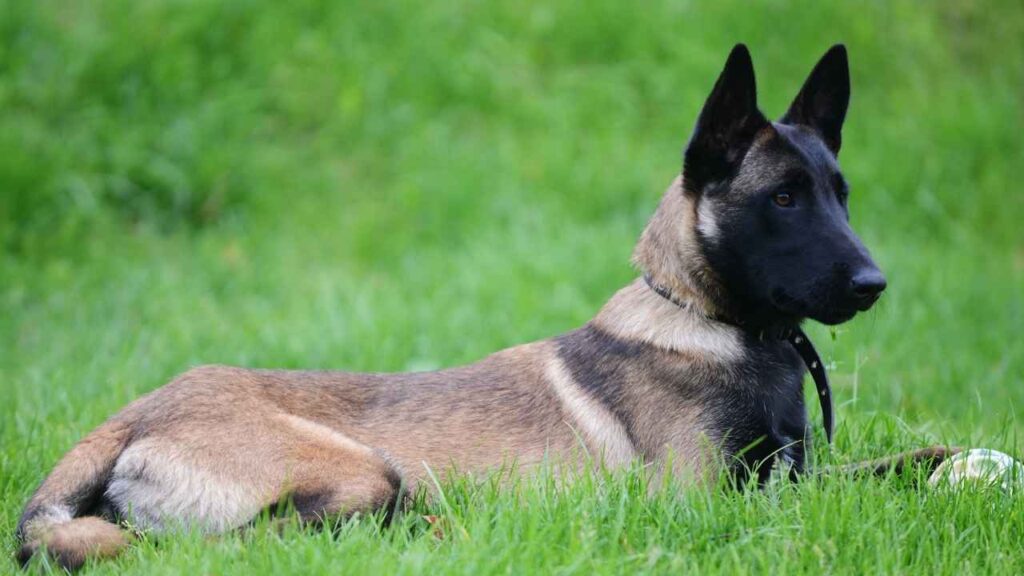
They thrive on challenge, structure, and consistency — and they notice everything, even subtle cues. However, this mental sharpness can turn into restlessness if not kept mentally engaged.
Rhodesian Ridgebacks, on the other hand, are smart but independent. They aren’t eager to please in the same way the Malinois is. Training a Ridgeback means working with a dog that likes to think things through before responding. They’re not stubborn, but selective. Patience, positive reinforcement, and trust go a long way with them.
Task-Oriented vs. Selective Obedience
The Malinois is perfect for roles requiring discipline, military, protection, agility, and scent detection, as mentioned in WebMD. In contrast, Ridgebacks need a strong bond and calm consistency to reach their full potential. Both can be trained well, but their approaches differ greatly.
Energy Levels and Exercise Requirements
Nonstop Energy vs. Measured Drive
The Belgian Malinois has one of the highest energy levels of any dog breed. Structured training, obstacle work, long hikes, or herding simulations are ideal.
Malinois are not suited for passive households. Without regular physical and mental outlets, their energy often turns into destructive behaviors.
By comparison, the Rhodesian Ridgeback is energetic, but more balanced. According to Orvis, they enjoy off-leash runs and long outdoor sessions, but they also know how to switch off indoors. They’re more reserved and measured in their energy output, especially once matured.

Age Plays a Role
Young dogs of both breeds demand more intensive activity and engagement. But by the time they become adult dogs, Ridgebacks typically settle into a more relaxed rhythm, while the Malinois keep their motor running well into adulthood. That’s a key difference many owners overlook.
Bite Strength and Oral Characteristics
Strength That Comes with Purpose
While neither breed is known primarily for its bite strength, both have a powerful grip when needed, though for very different reasons. The Belgian Malinois has an estimated bite force of around 195 PSI, used with precision during protection work. Their grip is firm but controlled, trained more for holding than for harm.
In contrast, Rhodesian Ridgeback dogs were originally bred to hold large prey at bay, not to take it down. Though exact numbers on their bite force are limited, estimates suggest a bite between 225 to 250 PSI, giving them a slightly stronger raw bite than the Malinois. That extra strength ties back to their original purpose — endurance hunting in tough terrains, not aggression.
Why Bite Force Isn’t Everything
It’s worth noting that bite force doesn’t automatically equal danger. Temperament, training, and context matter far more. Between the two, Malinois are more likely to use their bite in controlled scenarios, while Ridgebacks are more restrained unless truly provoked.
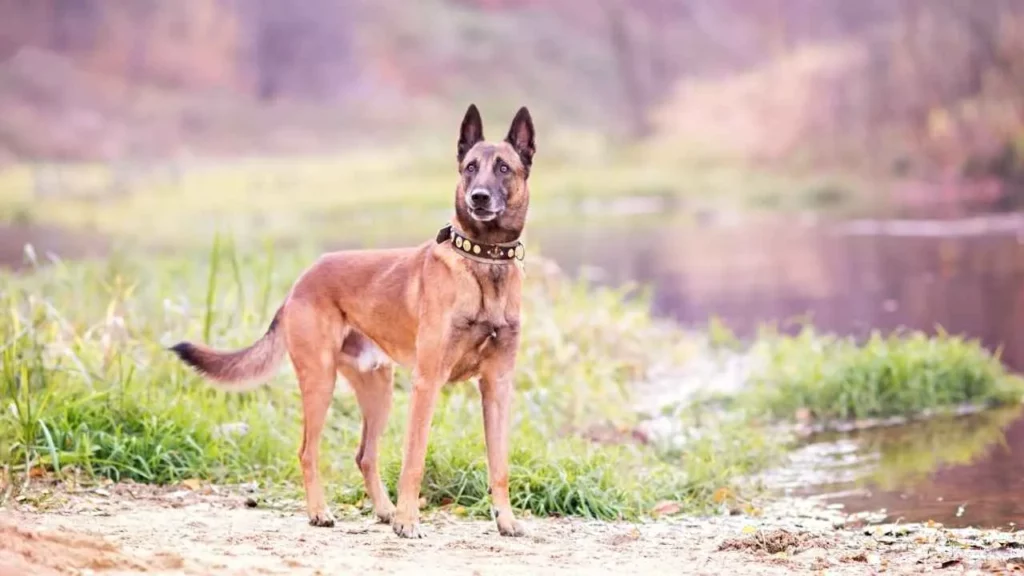
Health Conditions and Lifespan Expectations
Belgian Malinois: Strong but High-Drive Comes with a Cost
Belgian Malinois are generally healthy, but their athletic, fantastic personality means they push their physical limits, which can lead to issues like hip and elbow dysplasia if overtrained early.
They may also develop progressive retinal atrophy or epilepsy in some lines. Regular health screenings are key. When sourced from reputable breeders, the chances of inherited problems drop significantly.
Their lifespan averages 12–14 years, and with the right balance of exercise and mental stimulation, many live active lives well into their senior years. But under-stimulation often leads to stress-based behaviors that can wear them out faster than a few breeds with lower energy demands.
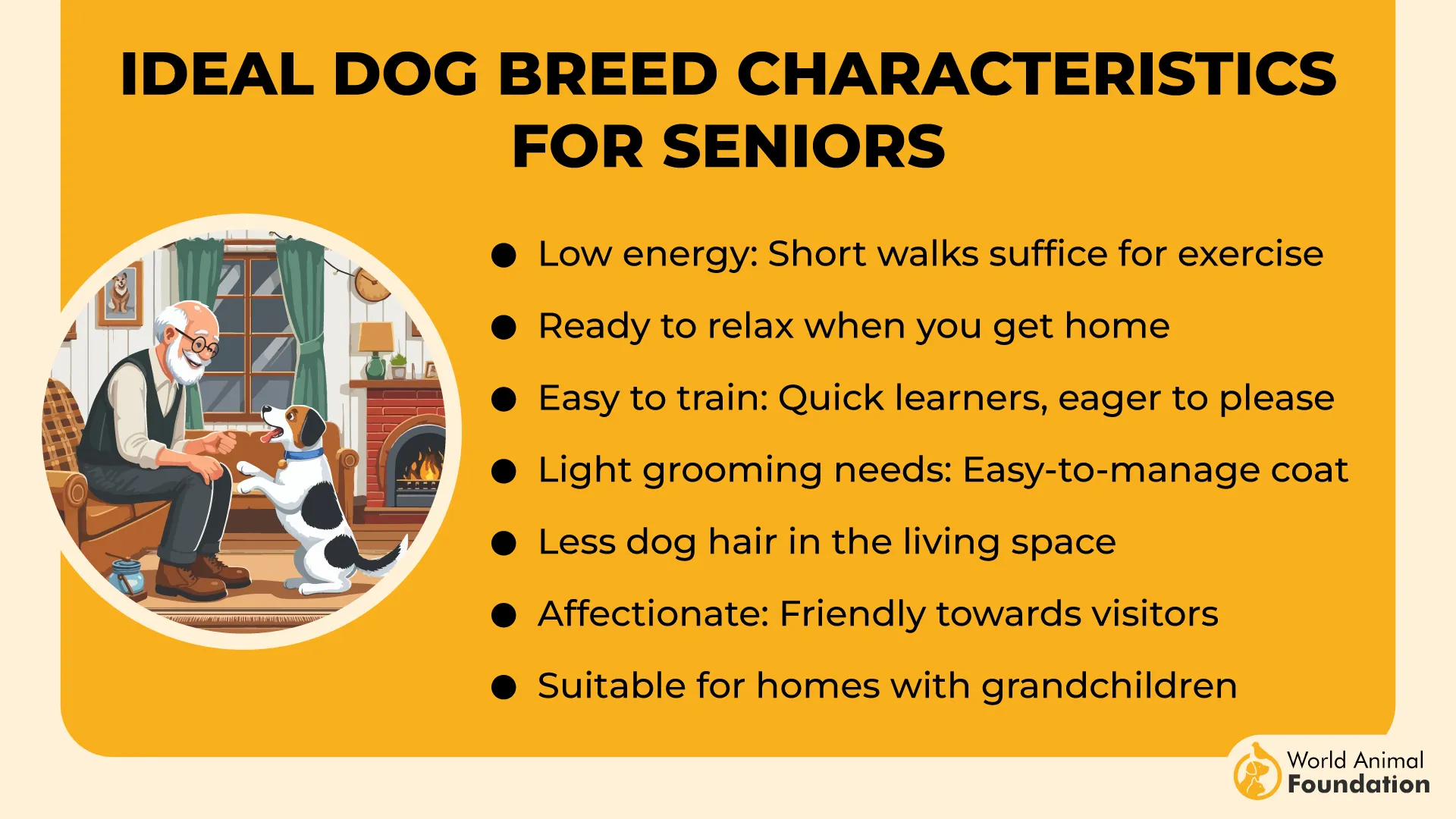
Rhodesian Ridgeback: Tough, with a Few Cautions
Rhodesian Ridgeback dogs are known for their sturdy constitution, but they aren’t immune to health conditions. Dermoid sinus is one of the biggest concerns in the breed — a congenital neural tube defect that should be screened for at birth, as mentioned in UFAW. Like many large dogs, they’re also prone to hip dysplasia and bloat (gastric torsion).
The average lifespan ranges between 10–12 years. Choosing a pure bred Ridgeback with good lineage and regular vet checks can help prevent early complications. Compared to other dog breeds of similar size, they tend to age steadily if kept at a healthy weight and active.
Grooming Needs and Allergy Considerations
Belgian Malinois: Low-Maintenance, but Not Hypoallergenic
The Malinois has a short, dense coat that doesn’t tangle — but don’t let that fool you. They shed more than people expect, especially during seasonal changes. While not a heavy groomer’s nightmare, they aren’t ideal for allergy sufferers, as they lack minimal shedding status and aren’t hypoallergenic.
Weekly brushing and occasional baths usually do the job, though during molting periods, brushing several times a week helps. Their coat is more about maintenance than style, and cleanliness is easy to manage with a regular routine.
Rhodesian Ridgeback: Easy Coat, Skin Sensitivities
Ridgebacks are praised for their sleek, single-layer coat, short, smooth, and relatively easy to care for, as highlighted in Legacy Rhodesian Ridgeback.
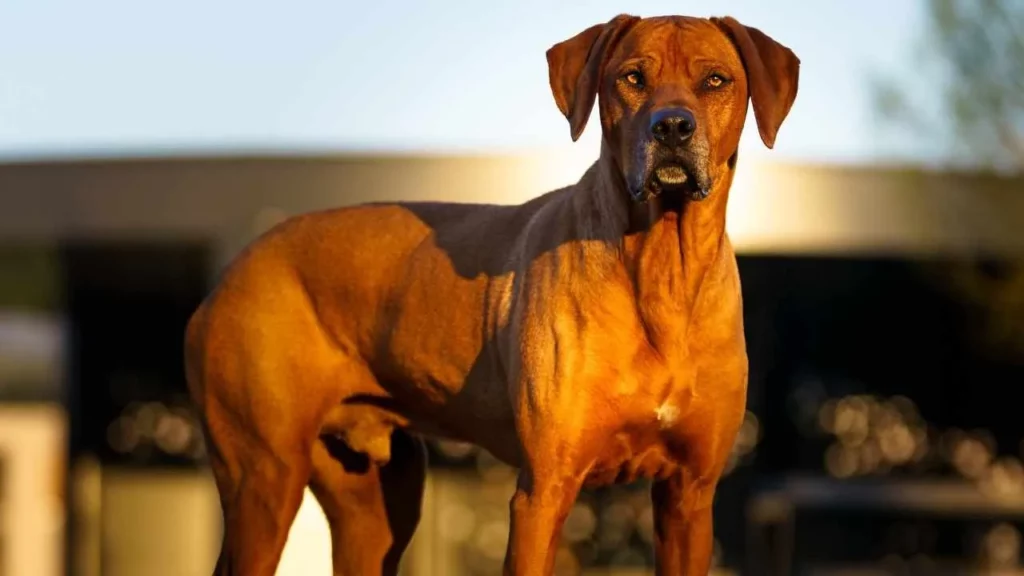
Brushing once a week is usually enough. They rarely develop mats or tangles, and like some other breeds, they’re naturally clean dogs. However, their skin can be sensitive to certain shampoos or food ingredients, especially if sourced from low-quality lines.
While they shed less than other dog breeds, they are still not ideal for allergy-prone homes. The plus side? Their grooming needs are minimal, and they’re often described as affectionate dogs who actually enjoy the bonding time that grooming brings.
Proper grooming also helps build trust, and with Ridgebacks being extremely loyal, that trust goes a long way in handling them during care routines.
Conclusion
At their core, both the Rhodesian Ridgeback and Belgian Malinois offer loyalty, strength, and unmatched devotion. But they serve different types of homes.
The Malinois excels with structure, excelling in dog sports, protection work, and families willing to invest in training classes. If you’re a young and active couple, your need for daily challenge and purpose may align perfectly with your lifestyle.
In contrast, the Ridgeback is a more measured companion. They make a wonderful pet for those who appreciate quiet confidence, fewer demands, and a fiercely, genuinely loyal nature. Though not always easy to train, their willingness to bond on their own terms brings a different kind of reward.
Whether you need a high-octane active dog that thrives on daily goals or a grounded family guardian, both breeds are specific dogs deserving of respect. The right one will match your pace and become part of your world.


